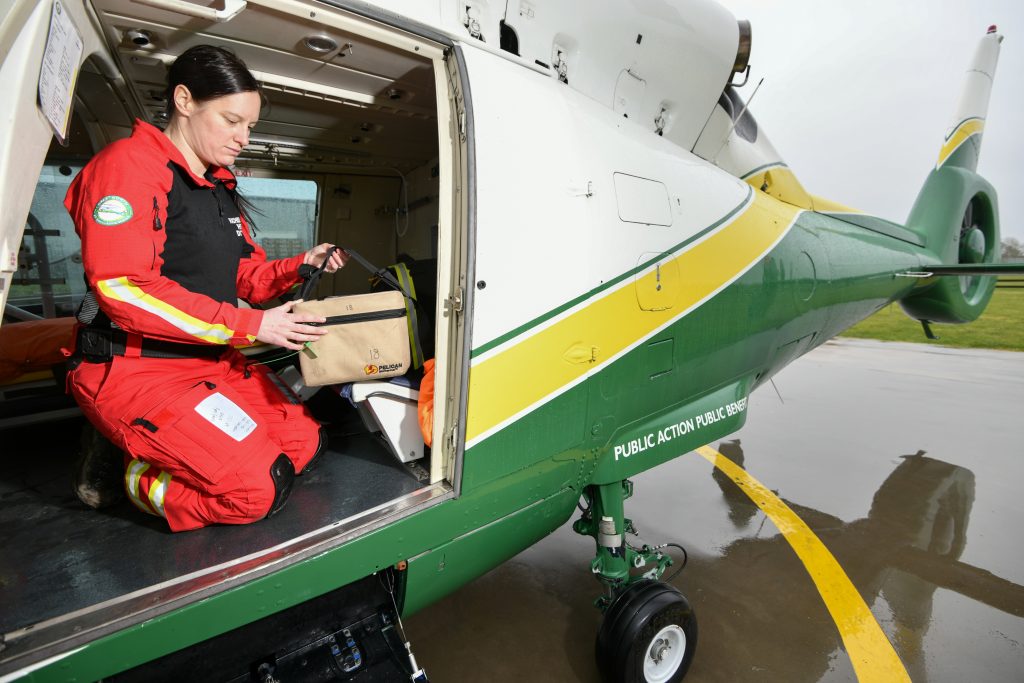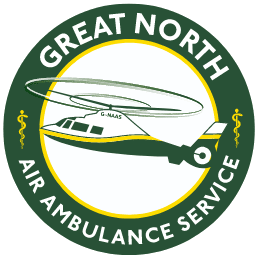At GNAAS, no two days are the same for our critical care team.
When our pilots, doctors and paramedics arrive at the base for their shift, they don’t know how many times they’ll be called out, what type of incidents they will face, or the locations they’ll be travelling to.
However, what remains a constant during their shift is how they prepare for the day ahead.
Here we explain what a ‘typical’ morning is like at the base.
7.30am
On a daily basis, a volunteer from both Northumbria Blood Bikes and Blood Bikes Cumbria collects a cool box containing blood products from the Royal Victoria Infirmary’s blood laboratories.
The cool boxes are then transported to our bases – Progress House, Eaglescliffe and Langwathby, near Penrith, and a team member who is on shift for that day will collect it from outside the base and take it straight into the hangar where it will be loaded onto the helicopter.


At this time the pilots will be carrying out their daily checks to make sure they’re good to go if they’re tasked to an incident.
They need to check the weather to make sure that there is nothing preventing them from flying, such as low cloud, reduced visibility due to fog, mist, snow, or haze.
They also must be aware of the freezing level that day in certain areas, which is when the temperature of the cloud is 0 degrees or below.
The pilots also use an online system to look at the daily NOTAMS, which are notices that alert them of any activity or obstacles that they need to be aware of that day, like range danger areas, military exercises, cranes, paragliders, or drones.


Next on the list is to look at their electronic flight book on the iPad to check that their maps and charts are up to date in the region.
They then calculate the mass and balance of the aircraft based on temperate and atmospheric pressure. This means they have to calculate the weight of the team who will be flying with them plus fuel to work out what their take-off weight is, as it must meet certain criteria before they can fly.
Afterwards the pilots check the aircraft technical log – this is a document they carry on every flight in a fireproof bag which states things like when the helicopter was last serviced and how long until the next one.
The technical log also contains information such as where the team have flown to, at what time, how many times they’ve landed, and where they landed.
7.40am
It’s now time to check over the aircraft for the morning and prepare them for flight.
Our pilots always do a visual inspection of the aircraft and check things like lights, leaks, panels, plugs, engines and blades.
They’ll also get out the base fire extinguishers and then check our onsite fuel system and complete a water-sediment test with a type of litmus paper to check whether the fuel is contaminated with any water. If it is, the pilot needs to flush the fuel lines until it is clear, or they can’t use the fuel.
While the pilots are checking over the aircraft at each base, the doctors and paramedics will be checking the kit to make sure they are ready to respond to their first call-out.


They will go through a checklist for their kit bags and make sure everything is there that should be. They make sure that all of the medicine they need is tagged and unused and they test all of the medical devices to ensure they’re working, including the ultrasound and ventilator.
While the helicopter is usually operated during the day, in cases where the helicopter cannot fly, such as due to inclement weather, or it gets dark quite early in the evening, the team will transfer onto a rapid response vehicle.
For these reasons, the team make sure the cars and aircraft are both fully stocked with kit so whichever mode of transport they have to use, all of the drugs and equipment they may need is already there.
They will also check over the rapid response vehicles to make sure the sirens and the blue lights are working.


8am
The aircraft will have been towed by a tractor out of the hangar and will now be online, with the team available to respond.
If they don’t get called out straight away, the team will get a cup of coffee or tea and the duty pilot will give them a morning brief. The brief usually contains information about the weather, anything the team needs to be mindful of, aircraft updates, and safety information.
Following this, it’s time for the medical morning brief.
During this brief, the team find out about adverse events that may have happened through the night, update policy and discuss statistics such as how many call-outs they’ve done that week or month.


9am
After the brief, the team will carry out their daily tasks, including checking the dates on medicine, making sure the base is clean and tidy, washing the aircraft, and ringing hospitals to check on patients they’ve treated the day before.
They’ll also take part in training simulations with manikins that are based on possible scenarios they may face when they are called out.
These training simulations help our team keep on top of their knowledge base and practice, and ensure they’re well equipped to deal with a variety of incidents.


10am
On average our team are called out to five incidents a day, however they are usually the busiest during summer. This means that some days our team will be called out to several incidents back-to-back, and on other days they may remain on base and carry out essential tasks and training while waiting for the call.
Everything the team does is to help benefit the local community and in 2023 they experienced the busiest year on record and responded to more than 2,100 incidents. Our service currently costs £9.3m a year to run and we rely solely on public donations to survive. We know times are tough for many, but if you value the work that we do, and you are able to, please consider donating to help keep our service operational.



